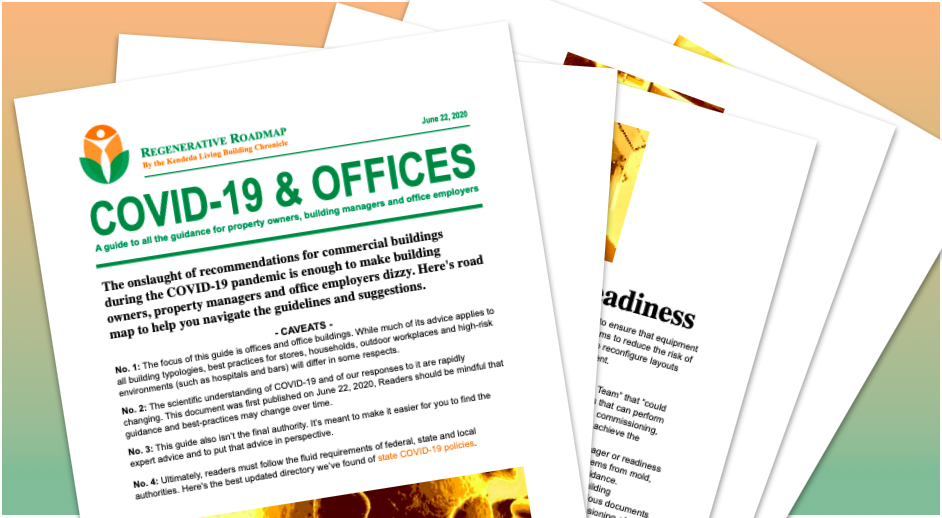The onslaught of recommendations for commercial buildings during the COVID-19 pandemic is enough to make building owners, property managers and office employers dizzy. Here’s road map to help you navigate the guidelines and suggestions.
– Caveats –
No. 1: The focus of this guide is offices and office buildings. While much of its advice applies to all building typologies, best practices for stores, households, outdoor workplaces and high-risk environments (such as hospitals and bars) will differ in some respects.
No. 2: The scientific understanding of COVID-19 and of our responses to it are rapidly changing. This document was first published on June 22, 2020, Readers should be mindful that guidance and best-practices may change over time.
No. 3: This guide also isn’t the final authority. It’s meant to make it easier for you to find the expert advice and to put that advice in perspective.
No. 4: Ultimately, readers must follow the fluid requirements of federal, state and local authorities. Here’s the best updated directory we’ve found of state COVID-19 policies.
PDF version
Download a PDF version of this report here
Plan
 Develop an infectious disease preparedness and response plan. Various guidelines suggest organizing plans in different ways. For simplification, we’ve broken the topics into two categories: Building & Office Readiness and Behavior & Operations. You should customize your plan to meet your needs. As you develop it, remember to:
Develop an infectious disease preparedness and response plan. Various guidelines suggest organizing plans in different ways. For simplification, we’ve broken the topics into two categories: Building & Office Readiness and Behavior & Operations. You should customize your plan to meet your needs. As you develop it, remember to:
- Consider special accommodations for members of groups that face higher risks.
- Monitor websites of key agencies for latest advice. This includes the Centers for Disease Control and Prevention and the Occupational Safety and Health Administration.
- Keep up with guidelines from local and state authorities, and follow local laws and regulations.
- Keep abreast of local conditions. While the White House has developed a very general three-phased approach to reopening states, most of the recommendations below will remain relevant under all conditions.
- Communicate relevant aspects of the plan to employees (if you’re an employer) and to tenants (if you’re a property owner or manager). Provide information on relevant programs and workplace regulations, and train employees if necessary.
Building & Office Readiness

Building owners and property managers should work with contractors to ensure that equipment is in working order and that adjustments are made to mechanical systems to reduce the risk of disease transmission. Businesses may wish to consult with architects to reconfigure layouts and address potential hazards while maintaining a good work environment.
Reduce risks inherent in reopening a building
ASHRAE recommends that building owners create a “Building Readiness Team” that “could include professionals and licensed and certified individuals and companies that can perform the analysis, testing, design, construction, control programming, balancing, commissioning, maintenance and operation services required to make the adjustments and achieve the performance included in these recommendations.”
- If the building has been closed for an extended period, the building manager or readiness team should take steps to protect occupants, plumbing and building systems from mold, Legionella and other microbial hazards. This CDC document provides guidance.
- In addition to plumbing, building systems to be checked include HVAC; building automation and control systems; testing, adjusting and balancing; and various documents and controls. As ASHRAE puts it: “This could be viewed as tactical commissioning of the systems to determine risk areas for the building operating in epidemic conditions.”
- It also might be a good idea to disinfect refrigerators and other cold-storage locations where SARS-CoV-2 may be able to survive for longer periods than normal.
Improve indoor air conditions
According to a “Statement on airborne transmission of SARS-CoV-2” issued by ASHRAE: “Transmission of SARS-CoV-2 through the air is sufficiently likely that airborne exposure to the virus should be controlled. … Changes to building operations, including the operation of heating, ventilating, and air-conditioning systems, can reduce airborne exposures.”
Building owners, property managers and office managers should consider adjusting mechanical systems to reduce the risk of viral transmission. Jump to the relevant sections on this page (the entire document should be reviewed by all building managers or their reopening teams).
- Increase ventilation and adjust ventilation controls.
- Upgrade and improve filtration.
- Consider energy savings, exhaust air re-entrainment.
- Prepare systems to maintain 40 percent to 60 percent humidity inside the building.
- Adjust elevator ventilation and filtration to reduce risk to occupants.
In addition to the documents cited above, these two sets of slides from the ASHRAE Epidemic Task Force address plumbing and indoor air are relevant:
Physical changes to office space and common areas
Per Reboot Readiness: A Primer on How to Design Contagions, published by HDK Inc.:
- Reconfigure seating and workstations to allow at least six feet between individuals
- Prepare for controlled access, and better circulation and flow.
- Identify access points and paths of travel for staff and visitors.
- Identify isolation areas for those who are showing symptoms of a contagion.
- Consider widening circulation paths and/or identifying certain halls and passageways as one-way.
- Reduce the need to touch surfaces and buttons, and “maximize cleanability.” Among the possibilities for touchless controls: exterior doors, interior doors, trashcans, elevators, water fountains, sink faucets, and toilets.
- Consider closing common dining and break rooms, and limiting the use of vending areas. (Employees may be encouraged to eat at their workstations or outside.)
- Consider restricting bathroom use to one person at a time.
Install signage and markings
- Install signage to encourage risk-reducing behavior by tenants and visitors. Among the topics that such signs might cover: Social distancing, proper mask hygiene, hand washing, close the toilet seat, and what to do if you have symptoms. See “Encourage employees to care for themselves” below). Six downloadable posters and handouts can be found under Communication Resources on this page; a more extensive library of downloadable posters and handouts can be found here.
- Mark six-foot distances. While it would be impractical for every location where people must stay six feet away, key locations can be marked with tape on the floor, decals that are available on the web, and other means. This also serves the purpose of reminding occupants of what six feet looks like.
Behavior & Operations
 Authorities are clear that social distancing and personal protection remain the most potent tools against the spread of coronavirus. Building operators and office managers can enhance protection by reducing the chances that sick people get in contact with other workers, and by encouraging behavior that reduces risk for everyone.
Authorities are clear that social distancing and personal protection remain the most potent tools against the spread of coronavirus. Building operators and office managers can enhance protection by reducing the chances that sick people get in contact with other workers, and by encouraging behavior that reduces risk for everyone.
Monitor building occupants and encourage self-monitoring
- Scan employees with a thermometer upon arrival on a daily basis. Be aware: This isn’t a fail-safe step. Also, there are some indications that tried-and-true technology may be more dependable than expensive “cutting edge” solutions.
- Ask that employees to self-monitor for symptoms.
- Encourage anyone who is sick to stay home.
- Develop a procedures to isolate employees with symptoms of COVID-19.
- To the extent possible and practical, reduce the density of workers through such means as teleworking (download PDF in upper right corner) and alternating shifts.
- Limit occupancy and set other protocols for elevators.
Encourage employees to care for themselves by …
- using stairs rather than elevators,
- washing their hands properly and regularly,
- wearing cloth face coverings when and where feasible,
- covering coughs and sneezes,
- putting the lid down before flushing the toilet,
- maintaining a social distance of at least six feet from coworkers, customers and other occupants,
- avoiding in-person meetings as much as possible, especially meetings in small or poorly ventilated rooms, and
- spending time outside, including holding meetings — if they must be held in person — on porches, patios and other in-between spaces while maintaining social distancing and personal protection (In general, outdoor spaces such as patios and porches are believed to be less hospitable to the SAR-CoV-2 virus. For offices where patio and porch access requires use of elevators, however, the risk may outweigh the benefit.)
Empower and train employees
- Familiarize tenants and employees with the steps you’re taking so that they can play a part in the effort. Also point them toward helpful, authoritative websites for tips on self-care. Here’s a good one.
- Make available to employees: cloth face coverings, tissues, alcohol-based hand sanitizer (with at least 60 percent alcohol), disposable towels and safe sanitizer that employees can use to to rub down work stations.
- Consider making mental health services available to employees, if not already available. And let employees know about those services. Here are eight examples.
Clean safely and effectively
- Develop a plan specifically for maintenance and janitorial services. Here’s an excellent detailed slide presentation.
- While cleaning pretty much everywhere reduces hiding places for pathogens, disinfection is only necessary under most circumstances on the most frequently touched surfaces.
- Institute a more intensive cleaning and disinfection for spaces that an infected person has used or occupied.
- Use disinfectants on the Environmental Protection Agency’s “List N: Disinfectants for Use Against SARS-CoV-2.” Closely follow instructions for disinfectants, don’t overuse them and consider less toxic alternatives if feasible.
- One way to avoid toxic disinfectants: Cross-reference that those on List N with disinfectants that either have obtained the EPA’s “Design for the Environment Logo for Antimicrobial Pesticides,” or have earned a “B” grade or better from the Environmental Working Group. Two potential exceptions: Steam cleaners and electrochemically activated systems may offer non-toxic disinfectant alternatives; but they may qualify for such lists because they involve operating equipment and often don’t include chemical products to test.
- If you place cleaners or disinfectants in bathrooms or other locations for self-use, ensure that they are nontoxic products and include simple instructions.
Rinse. Repeat.
 Our understanding of COVID-19 and the best practices to reduce hazards are constantly evolving. All advice from this guide and many of its links are subject to the caveats at the top. we can’t stress enough that it’s important to keep up with regulations, as well as the latest advice from public health experts.
Our understanding of COVID-19 and the best practices to reduce hazards are constantly evolving. All advice from this guide and many of its links are subject to the caveats at the top. we can’t stress enough that it’s important to keep up with regulations, as well as the latest advice from public health experts.
Authoritative websites such as CDC, EPA and ASHRAE, as well as state and local officials, are crucial. It’s also important to seek guidance from credible professionals — mechanical engineers on the heating, ventilation and air conditioning systems, for example, and architects on space, light and occupant behavior.
Of course, we’d love for you to refer back to this document as a resource. As you do so, however, it’s important to recognize that COVID-19 is a moving target, so we urge you do keep up with the latest information.
IMAGE CREDITS: Illustration at drawn from image SARS-CoV-19 virus cells by U.S. Food & Drug Administration. Other photo illustrations drawn from photos by Ken Edelstein.


